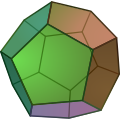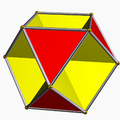corner
The corner , also the corner point , is a particularly distinctive point in geometry on the boundary line or surface of an area .
The corners of two-dimensional polygons (polygons) are the points at which the delimiting lines, the sides , meet. In the case of three-dimensional polyhedra ( polyhedra ), the points at which (at least) three of the bounding surfaces meet as corners. The corners of polyhedra are the endpoints of the edges .
In the case of a convex n-dimensional polytope , a corner is characterized by the fact that it cannot be represented as a real convex combination of two different points of the polytope ( extreme point ).
For three-dimensional polyhedra there is an equation that describes a relationship between the corners, edges and surfaces of any convex polyhedron, the Euler's polyhedron set .
A regular pentagon has 5 corners and 5 sides.
A regular dodecahedron has 12 faces (hence its name), 20 vertices and 30 edges.
Corners in linear optimization
Corners play an important role in linear optimization , since it can be shown that the optimal function value is always assumed in a corner of the restriction set. The simplex algorithm in particular makes use of this by running systematically from corner to corner until it has found the optimal function value. The basic admissible solutions that are used here are precisely the corners of the polyhedron.
Differentiation of corners
To differentiate between mostly right-angled corners, one speaks of "inside" and "outside corners". In the case of a convex polygon , the angles of the corners are always smaller than 180 ° when viewed from the inside and always greater than 180 ° when viewed from the outside. A corner is called an "inside corner" if its angle is less than 180 °. Otherwise it is an "outside corner". With rooms there are corners that you look into, inside corners and corners that protrude outside corners. The consideration is relative, that is, in relation to the object. The floor of a room lies with its outside corners in the inside corners of the room. These inside corners are correspondingly on the outside corners of the floor.
See also
- In graph theory there is the related concept of " nodes ",
- In projective geometry , points in a general position are called corners . There you determine important figures such as the complete square .
literature
- Johannes Böhm, Erhard Quaisser: Beauty and harmony of geometric shapes . Spheroforms and symmetrical bodies. Akademischer Verlag, Berlin 1991, ISBN 3-05-500704-2 .
- Dieter Grillmayer: In the realm of geometry . Part I: plane geometry. Books on Demand, Norderstedt 2009, ISBN 978-3-8370-2335-0 .
- Erwin Gureczny: polyhedra . Remarks about different approaches to general, regular and semi-regular polyhedra, their existence and possibilities of construction. Vienna University of Technology, Vienna 1993.
- Mario Holzbauer: Four-dimensional polytopes . Thesis. Vienna University of Technology, Vienna 2007 (with extensive bibliography).



